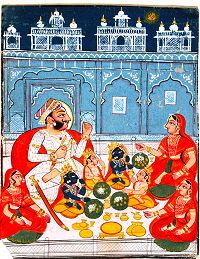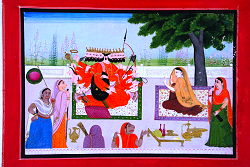
The portrait of Rama. Basohli style, Pahari, ca 1730. Paper, 14.8 cm x 10.2 cm. Acc. No. 63.1043 |
|
CINQUANTENAIRE MUSEUM
Parc du Cinquantenaire 10 – 1000 BRUSSELS
INFORMATION:
• Tel: +32 (0)2 741 72 11
• Website: www.mrah.be
• E-mail: info@mrah.be
OPENING HOURS:
• From Tuesday to Sunday: 10AM-5PM (ticket office closes at 4PM)
• Closed on Mondays and 25 December, 1st January and 1st May
• Closed at 2PM on December 24 and 31
ADMISSION PRICE:
€8/€6/€4
CURATOR:
Miriam Lambrecht, curator for India and South-East Asia collections
PRESS CONTACT:
Bart Suys, Head of the Communication Service
• Tel: +32 (0)2 741 73 00
• E-mail : b.suys@mrah.be

|
The Ramayana is one of the two great classic Hindu epic stories of India, the other being the Mahabharata. It is among the cardinal works of world literature and its central version was composed more than two thousand years ago by the legendary poet Valmiki. The exhibition is an opportunity to savour the art of the miniature, in which Indian painters displayed such great mastery in the unique way they painted man and nature.
 Rama and his brothers are enjoying their food in the company of Raja Dasharatha and his three queens in the palace of Ayodhya. Kotah style, Rajasthan, late 18th century. Paper, 28.5 cm x 22 cm. Acc. No. 62.450
The Ramayana, which was originally written down in Sanskrit and in seven books (kanda) of 24,000 couplets (shloka), relates the story of Rama and his consort Sita. The hero of the story is Rama, crown prince of Ayodhya, who – as a result of an intrigue at court – is banished with his wife Sita and half-brother Lakshmana to the forest, and spends fourteen years in exile. The beautiful and virtuous Sita is abducted through cunning by the ten-headed demon king Ravana, who lives on the island of Lanka (Sri Lanka). Rama, together with Lakshmana, begins a long and laborious search for his beloved wife Sita. After many adventures and severe ordeals, he finally succeeds in defeating Ravana, helped by the army of monkeys led by the monkey general Hanuman.
A major source of inspiration
The Ramayana is a story of courage, loyalty, friendship and justice, and has deep religious significance. Indians see Rama as a deity and still venerate him as one of the ten reincarnations of the Hindu god Vishnu, who assumed several avatars in order to appear on earth. Throughout the centuries, the epic has been a great source of inspiration for numerous artists, both in India and in the neighbouring countries of Thailand, Cambodia, Laos and Indonesia.
 Ravana proposes Sita for marriage in Asoka Vatika. Sita denies and warns him of the serious consequences with her finger. Kangra style, Pahari, early 19th century. Paper, 20.2 cm x 27.6 cm. Acc. No. 72.90
The exhibition consists of a hundred miniatures from the collection of the National Museum in New Delhi, India. Together, they illustrate the course of the entire Ramayana story and include some real treasures. At the same time, they provide a review of the major schools that, between the sixteenth and nineteenth centuries, worked the Ramayana into their imagery. The epic was a favourite theme among Rajasthani and Pahari painters, and it did not leave the muslim emperors from the Mughal dynasty unmoved. In 1588, indeed, the famous emperor Akbar had the Ramayana translated into Persian, a version that served to inspire several artists of the painter ateliers at the Mughal court. Besides, he also commissioned series of miniatures depicting the Ramayana story.
To see more illustrations, click on VERSION FRANCAISE at the top of this page
|










